STEAK MASTERCLASS
The experts share their tips for beefy perfection
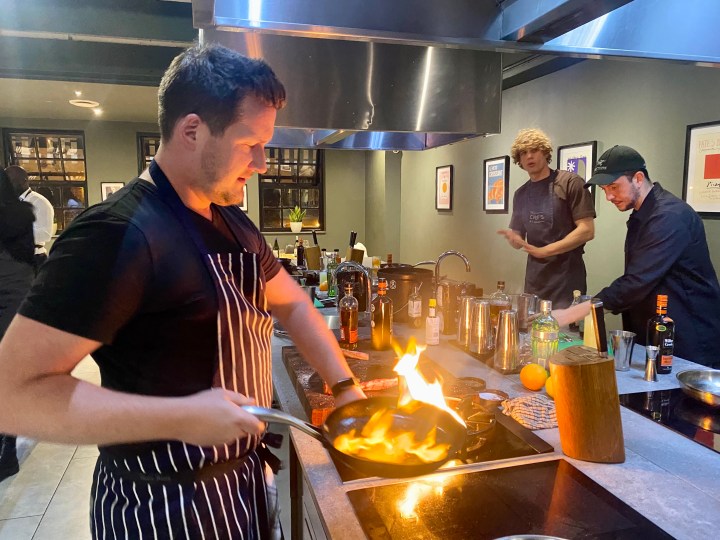
For all the tips and tricks for cooking a perfect restaurant-quality steak at home, turn to the experts for a masterclass.
There’s no reason why you can’t have your own restaurant quality steaks at home. So said Greg Bax of Rare Grill in Kenilworth, at one of the two steak masterclasses I attended last week.
It’s a good idea to have a decent butcher you trust and with whom you have a sturdy relationship, but even if you’re buying from one of the supermarket chains – and there’s nothing wrong with that – it’s probably all coming from one of the same big suppliers from which restaurants get theirs. One way to up your game is how well the steak is aged, and how it’s been taken care of; patience is important.
Dry ageing will yield the best results but we’re not all set up for that kind of temperature and humidity-controlled environment. Wet ageing, on the other hand, is as simple as ensuring the meat is properly vacuum sealed. That’s it. Just date it and leave it in the fridge for up to four weeks. There was mention of requesting a special dedicated part of the fridge to do this, and I can only imagine (and shudder at) the kind of household arrangements that would necessitate this. It reminds me how blissful it is to live alone, and not have to worry about anyone else messing with my meat.
Bax hosts his masterclasses once a month, but if you rustle up a crowd, you can book privately. The format is demonstrations with some interaction from the guests. It’s informal and questions are encouraged. Bax is not a professionally trained chef but has worked in kitchens for 25 years, from big steak house and grill chains to his own restaurant which won a championship the year it opened. You get a booklet to take home, which covers the syllabus for the evening, and in this case, glasses were kept topped up with some jolly nice wines courtesy of Damn Fine Brands. There’s an old vine Chenin from Roodekrantz that I have my eye on, which was the welcome drink, followed by some Spookfontein reds to go with the steak.
Bax talked about breeding, and grain fed versus grass fed, the grading system (tip: C grade is older and therefore tastier and better than the young A grade), and various cuts. The primal cuts we’re most familiar with are rump, sirloin and fillet, and Bax is of the opinion that they require different cooking times, particularly when compared to cuts from the hardworking forequarter. Low and slow for the front, fast and hot for the back.
The first steak Bax grilled for us was fillet, a notoriously tasteless and tender part of the animal. It doesn’t require ageing, he said, and a sauce is always recommended. In this case it was a béarnaise, a traditional steak sauce made with butter (lots), tarragon vinegar and eggs. It can be intimidating to make but Bax showed us a stick blender method. Purists can gnash their teeth and rend their clothing, but don’t knock it. I have a brilliant aioli recipe that requires everything being added to a jug and stick blended. It’s foolproof and delicious.
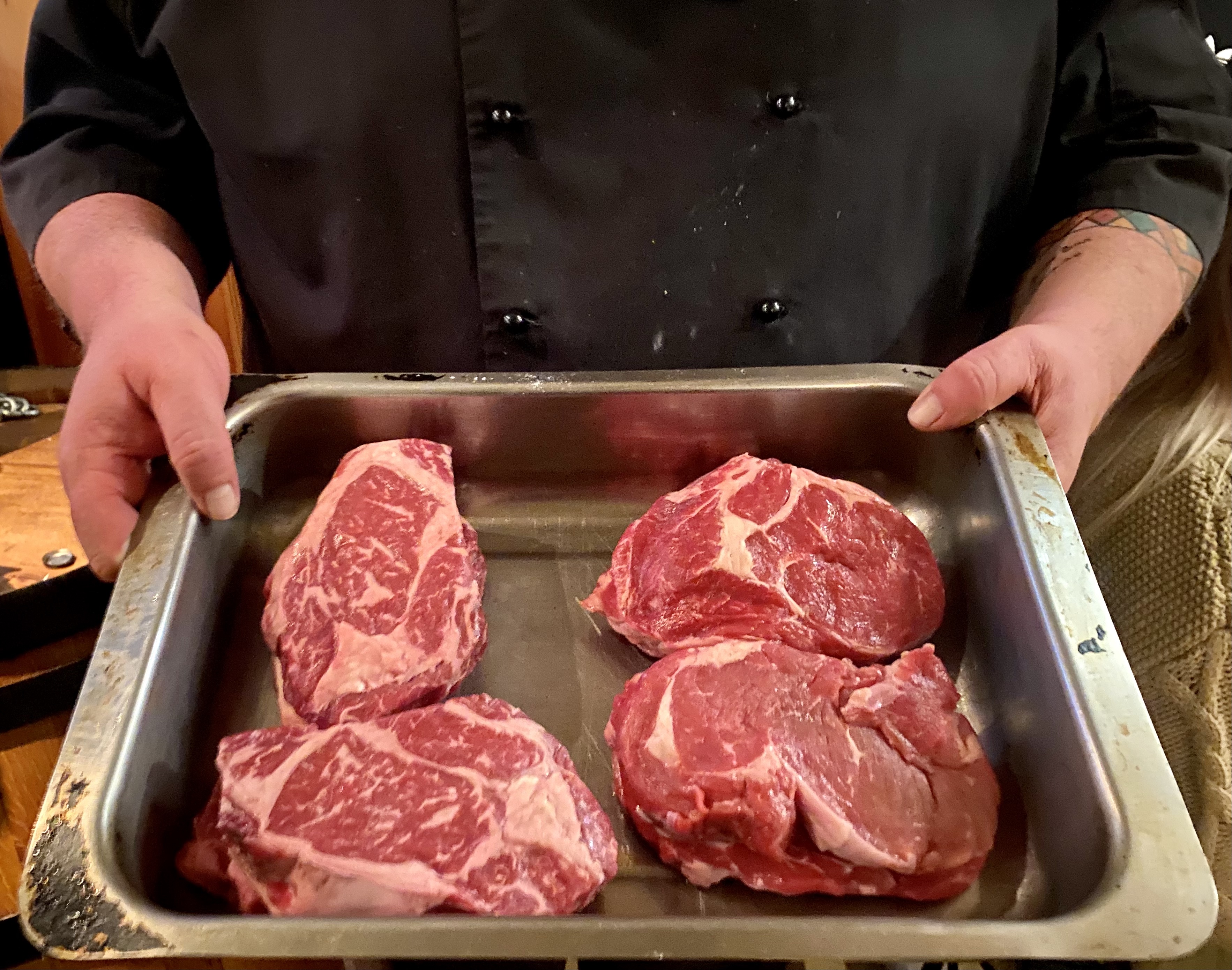
Two types of steak – grain fed and grass fed. Can you tell the difference? (Photo: Bianca Coleman)
For the main course, Bax brought out a tray with four ribeye steaks; two were from grass fed animals, two from grain fed. The grain fed ones were younger than the grass fed ones at slaughter. Grain fed cattle come from feedlots. Grass is what cattle were designed to eat. Anyway, we can be here all day arguing for and against either one, but tasting the two side by side (and you can see the distinction even in the raw meat) revealed a remarkable difference. The grain fed meat was bland and much fattier, somehow flabbier, and grass fed much more flavoursome (see my Instagram, where you can see the result of my braaied tomahawk as well, which was all I could do because in my excitement I didn’t think through the length of the bone and size of my skillet).
As for achieving the perfect doneness – or temperature as it’s trendy to say these days – there are a few ways to do this. “Never overcook steak,” cautioned Bax. “You can always fix an undercooked steak, just put it back on the heat. When I cook my steaks I try to make sure they are all the same thickness. Every centimetre of steak, that’s how many minutes per side for medium rare.”
So if the steak is 4cm thick, that’s four minutes each side, more if you want medium or – horrors – well done. Don’t even look my way. We can never be friends. I think what’s important with this method is to know your heat source intimately.
“You can turn it every 30 seconds, turn it once and finish it in the oven – this is the method that works for me, for a consistent, even grill. Nothing is cast in stone and I cannot guarantee anything I tell you tonight,” he said.
Resting the meat is critical, a step that should not be skipped. “What happens when you cook steak is that all the moisture gathers in the centre and tries to push up to get away from the heat,” explained Bax. “When you allow your meat to rest, the moisture redistributes throughout the meat, and every mouthful will be delicious.”
Pete Goffe-Wood’s method of testing if the steak is done is the one where you press it with your finger. The trick is to hold your thumb and forefinger together and touch the fleshy part of your thumb with your other hand. Forefinger is rare, middle finger medium rare, and so on. It might take a bit of trial and error but as Bax said, you can always put it back on the heat.
Goffe-Wood hosted his masterclass at The Chef’s Studio in Bree Street, Cape Town. The multi level building houses Grub & Vine, Culture Wine Bar, and the Blue Room jazz venue. Chef patron Matt Manning opened the latter two during the pandemic so he deserves a shout-out for that, and for hanging on and riding it out.
He popped in for a while, and in the end, cooked my steak for me plus he whipped up a peppercorn, cream, brandy and truffle sauce, and as much as I’m a strong independent woman perfectly capable of grilling her own steak, there are times when I’m happy to sip my wine and let the bloke get on with it. I’m not stupid.
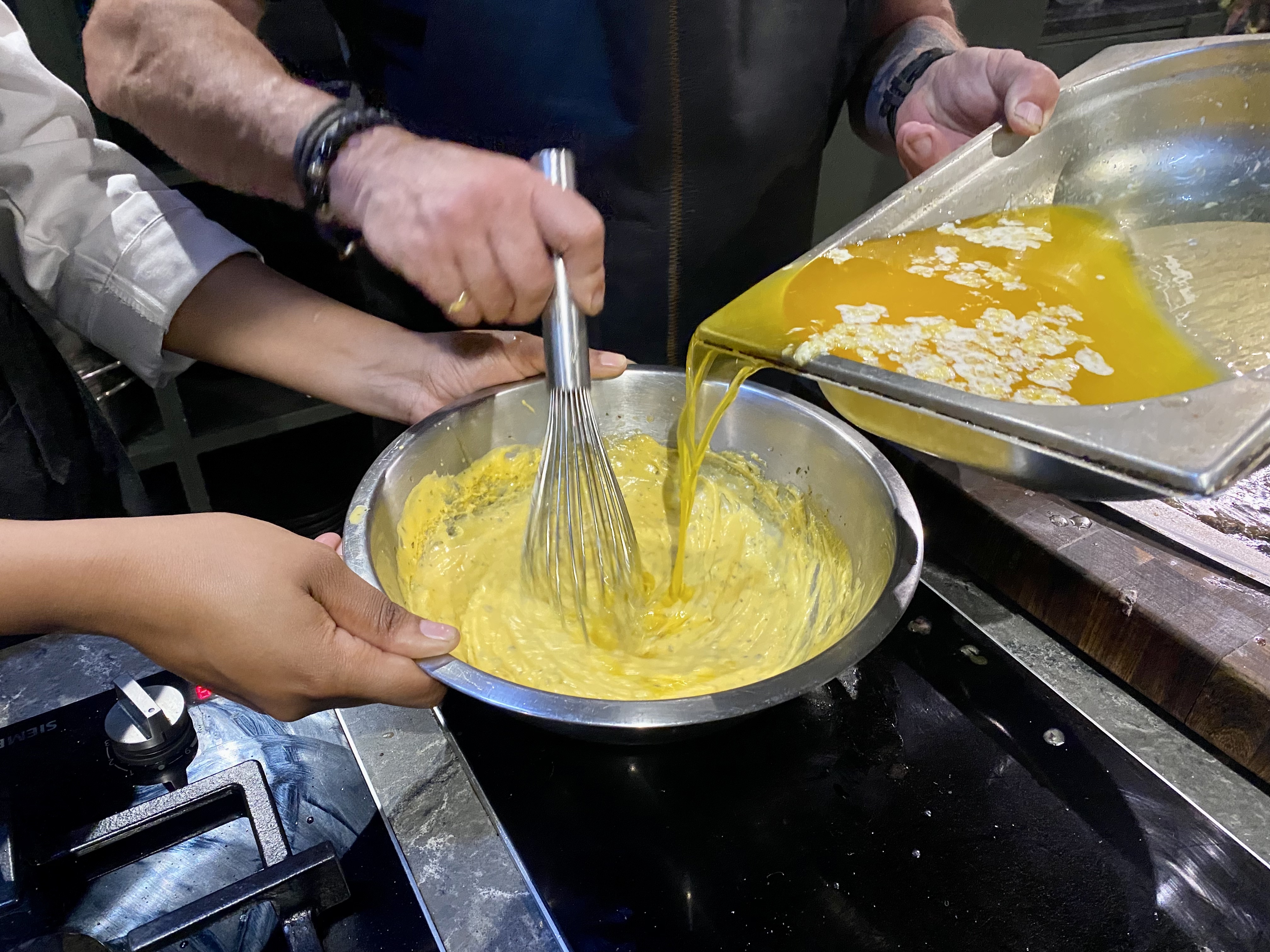
Both masterclasses included béarnaise sauce; Greg did his with a blender, Pete used a whisk. (Photo: Bianca Coleman)
This masterclass was as much about the steaks as it was about Goffe-Wood, whom I’ve known for way longer than the 14 years Facebook claimed this week (only because that’s how long I’ve been on Facebook), because I keep forgetting he’s a legit celebrity chef and everyone wants to talk to him and take selfies with him. Heck, even my own parents are impressed we’re on first name terms, not name-and-surname.
Goffe-Wood knows his stuff, especially when it comes to meat and fire and such, and is not shy about speaking his mind. “Fillet steak is possibly the worst steak in the world. It’s completely and utterly tasteless and has no value whatsoever,” he said. It chops up nice and soft so it’s good for tartare, on crostini, which is what we nibbled on at the beginning of the evening.
“What you are looking for, and what gives steak flavour, is fat and blood; external fat but also internal fat, which we call marbling. As you cook it it melts and softens and flavours the steak. Fillet has neither internal nor external fat. Its value is that you can cook it within an inch of its life and it will still be soft. And there begins and ends its value,” he said, to a ripple of laughter. “You can forget it on the braai and it’s never tough. People will tell you they have a fillet recipe and it’s always either marinated overnight or it’s wrapped in bacon or doused in sauce. You need to add flavour to fillet because it has none of its own.”
Like tofu.
“Rump is probably one of the most interesting and most maligned cuts, and the most flavoursome on the cow,” said Goffe-Wood. “What we in SA have learned is that the rest of the world has been grilling other cuts forever. We’ve squandered entire beasts for only four primal cuts – about 10% of the cow’s body weight.”
Consider ribeye and other steaks from the forequarter. Like the flat iron, named because of its shape. From the shoulder, it can be called butlers’ steak, feather blade steak or oyster blade steak. This is true of many cuts, that they have various names but are the same or similar part. Here’s a useful guide.
On the subject of flat iron, there were three fine pieces of Wagyu. Outrageously expensive, yes, but worth the outlay because you’re probably not going to be able to eat that much of it. “It becomes like eating a block of butter,” said Goffe-Wood. It sounds like a challenge, but okay.

Wagyu flat iron steaks for starters, which were sliced and served with a red wine and thyme butter. (Photo: Bianca Coleman)
“There are two schools of thought, in terms of seasoning meat. One, is that you season the meat before you put it on the fire, in the pan, or in the oven. The other is that you season during or afterwards. One is complete crap. One is the truth you will live from this moment on,” he said.
“And that is you always season beforehand. There’s science behind it. You will be told if you season before it draws all the moisture from the meat. True. But only if you season it three hours before you cook it. We’re talking about five minutes before cooking.
“The reason it’s important is that the moment it hits the pan, that salty crust cooks onto the outside of the meat and you get intense flavours. It’s the Maillard reaction.”
That’s real science and the internet is full of information.
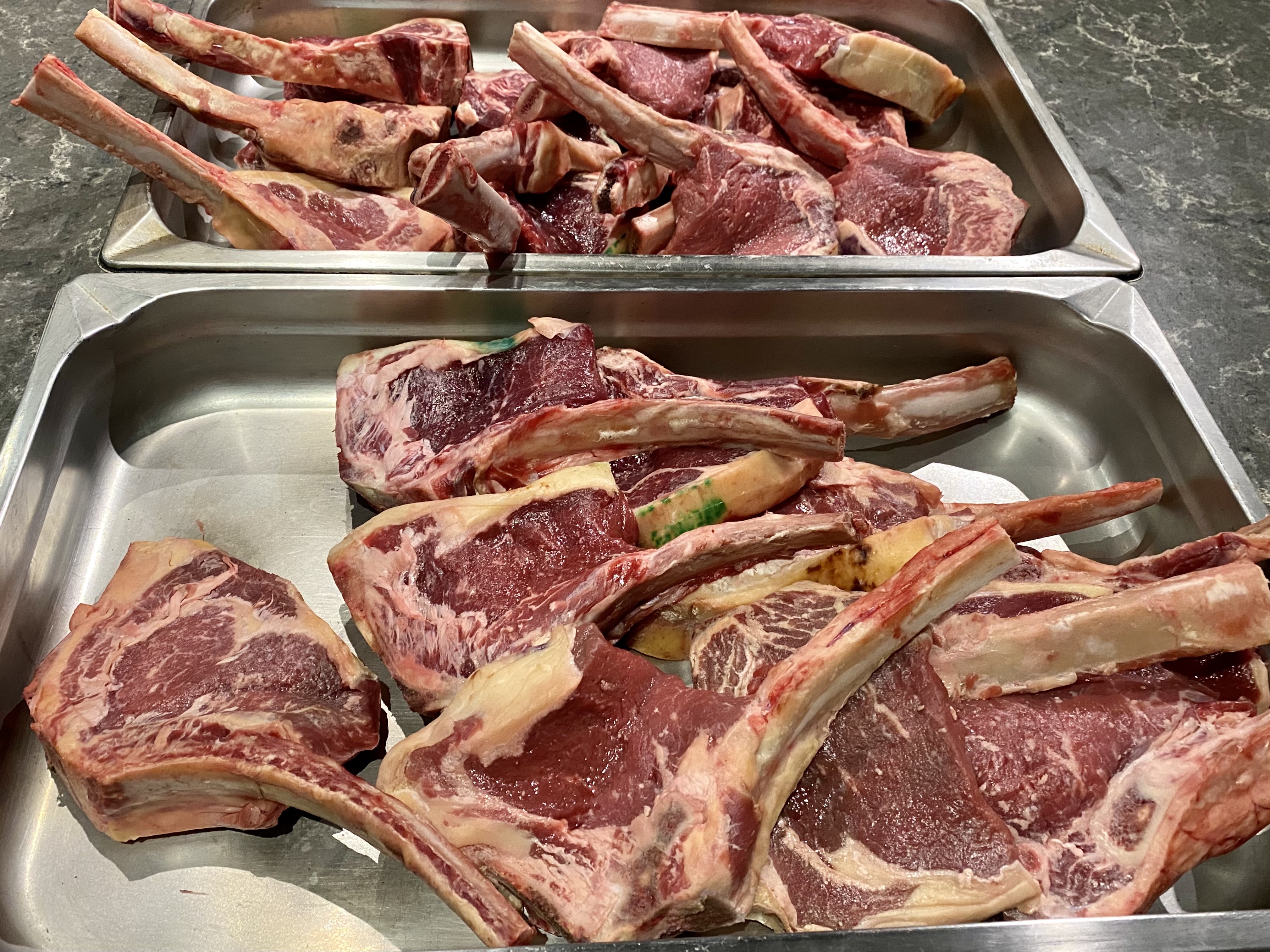
The tomahawk steaks – sirloin on the bone – ready to be cooked to perfection. (Photo: Bianca Coleman)
In simple terms we can all understand, it tastes good because the salt is cooked onto the outside. “It doesn’t mean it’s salty; it means it’s flavoursome. Salt brings out the natural flavours. If you add salt after you’ve cooked it, it’s just salty meat, which in no way enhances the cooking process,” said Goffe-Wood, who recommends you find a good non-iodised salt.
Stay away from marinades. They’re loaded with sugar and all they do is caramelise, and your lovely expensive steak – which really doesn’t need much done to it – will taste like burnt sugar. “If you’re hell bent on using it, brush it on afterwards for a smack of BBQ,” said Goffe-Wood.
You’ll do better making a delicious compound butter – which was melted into the already melty Wagyu which was oh-my-word-I-have-no-words, please bring me some more.
The evening was made more festive by the presence of Diageo brand ambassador Bradley Jacobs, and Sebastian Rodrigues from Sip Exclusive, who demonstrated two classic cocktails: a Tom Collins and an Old Fashioned, to which I am rather partial. Afterwards we were all invited to experiment and make our own. And then with what seemed like very little adult supervision, we were given sirloins on the bone and let loose in the kitchen. Goffe-Wood had shown us how to make a béarnaise the old school way, which he allowed to split so he could show us how to fix it. It was definitely in the script. Luckily we didn’t have to replicate it, or we would have been there all night. The lard-roasted potatoes were done for us, as were the roasted marrow bones. The plate was garnished with green beans.
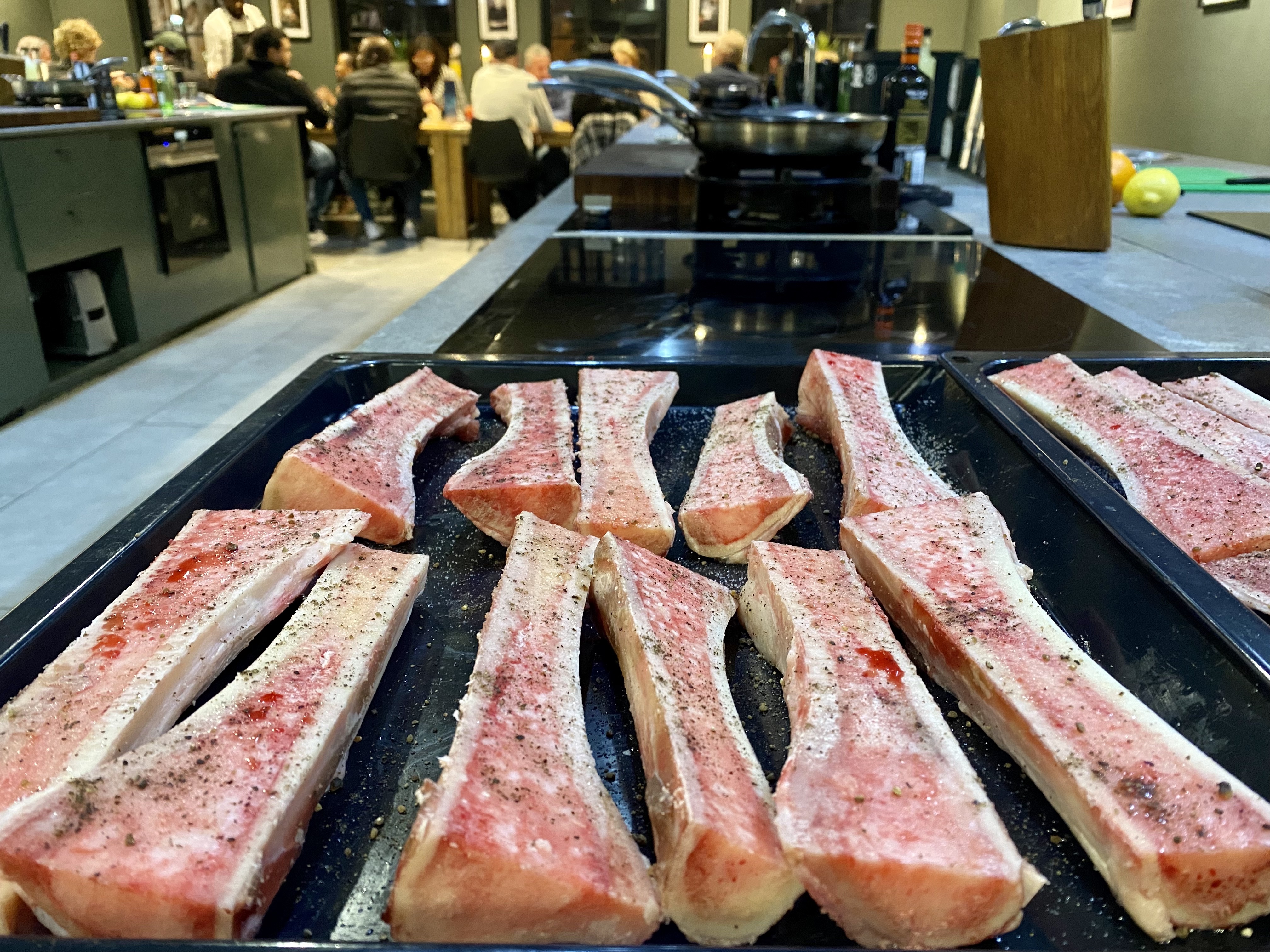
Marrow bones ready for roasting. (Photo: Bianca Coleman)
I don’t know how anyone else’s steak turned out but mine was perfect, thanks Matt. Here’s one more top tip (from Bax and Goffe-Wood): Worcestershire sauce (easier to write than say, especially after a few drinks). Use it as a seasoning, with some olive oil, that good salt (don’t hold back) and cracked black pepper. Worcestershire sauce is your secret weapon in the kitchen, for more than steak. You’re welcome. DM/TGIFood
The next Goffe-Wood masterclass is on October 26, 2022; there are a bunch of others you might like though. Click here. For Rare Grill classes, email greg@raregrill.co.za or call 076 460 0423. The Hussar Grill in Steenberg is doing steak masterclasses; the next one is on August 31, 2022.
Follow Bianca Coleman on Instagram @biancaleecoleman
The writer supports The Gift of the Givers Foundation, the largest disaster response, non-governmental organisation of African origin on the African continent.



 Become an Insider
Become an Insider
Comments - Please login in order to comment.